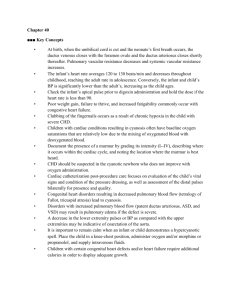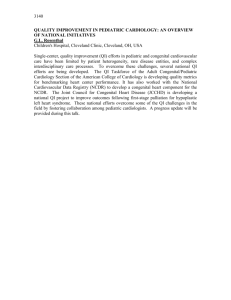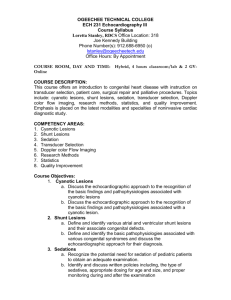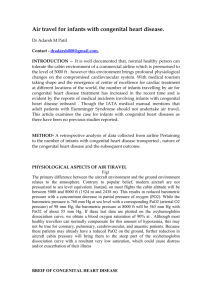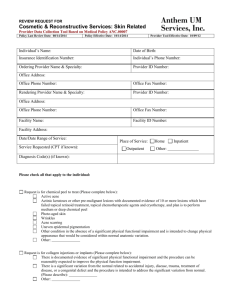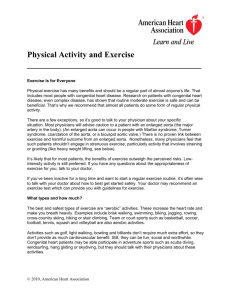Congenital Diseases
advertisement
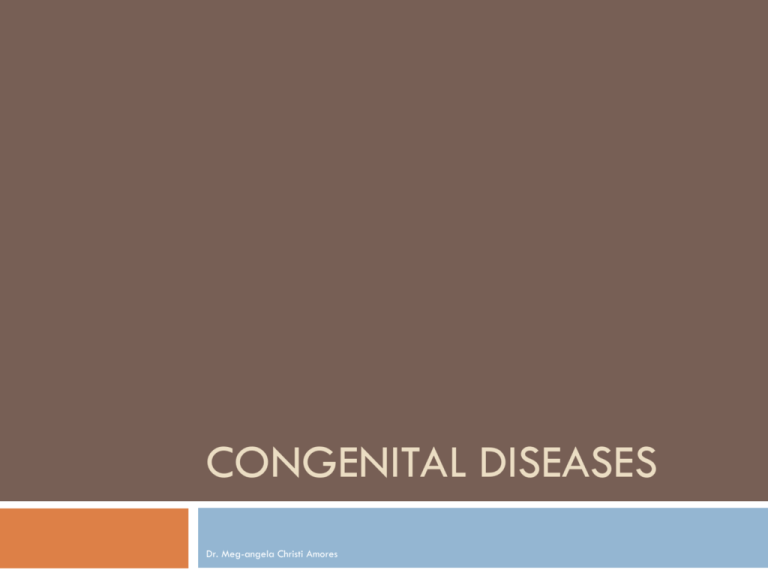
CONGENITAL DISEASES Dr. Meg-angela Christi Amores Congenital Heart Disease 0.5-0.8% of live births incidence is higher in stillborns (3-4%), abortuses (10-25%), and premature infants (about 2%) diagnosis is established by 1 wk of age in 40-50% of patients with congenital heart disease and by 1 mo of age in 50-60% Relative frequency of Major Congenital lesions Ventricular septal defect25-30 Atrial septal defect (secundum)6-8 Patent ductus arteriosus6-8 Coarctation of aorta5-7 Tetralogy of Fallot5-7 Pulmonary valve stenosis5-7 Aortic valve stenosis4-7 Relative Frequency of Major Congenital lesions d-Transposition of great arteries3-5 Hypoplastic left ventricle1-3 Hypoplastic right ventricle1-3 Truncus arteriosus1-2 Total anomalous pulmonary venous return1-2 Tricuspid atresia1-2 Single ventricle1-2 Double-outlet right ventricle1-2 Others5-10 Fetal circulation Congenital Disease Most congenital defects are well tolerated in the fetus because of the parallel nature of the fetal circulation only after birth when the fetal pathways (ductus arteriosus and foramen ovale) are closed that the full hemodynamic impact of an anatomic abnormality becomes apparent Etiology Cause is unknown There is progress in identifying genetic basis of many congenital heart lesions small percentage - related to chromosomal abnormalities, in particular, trisomy 21, 13, and 18 and Turner syndrome 2-4% -associated with known environmental or adverse maternal conditions and teratogenic influences, including maternal diabetes mellitus, phenylketonuria, or systemic lupus erythematosus diabetic mothers are five times more likely to have congenital cardiovascular malformations most congenital heart disease is still relegated to a multifactorial inheritance pattern Fetal echocardiography improves the rate of detection 2 major groups 1. 2. Acyanotic Congenital heart lesions Cyanotic Congenital heart lesions Acyanotic Congenital heart lesions Increased volume load: ASD (atrial septal defect) VSD (ventricular septal defect) AV septal defects PDA (patent ductus arteriosus) Increased pressure load: valvular pulmonic stenosis valvular aortic stenosis coarctation of the aorta Cyanotic Congenital heart lesions Decreased Pulmonary Blood Flow - obstruction to pulmonary blood flow and a pathway by which systemic venous blood can shunt from right to left and enter the systemic circulation tricuspid atresia Tetralogy of Fallot single ventricle with pulmonary stenosis Increased Pulmonary Blood flow Transposition of the great vessels Total anomalous pulmonary venous return Truncus arteriosus PDA (patent ductus arteriosus) Pathophysiology blood shunts left to right through the ductus from the aorta to the pulmonary artery pulmonary artery pressure may be elevated to systemic levels during both systole and diastole risk for the development of pulmonary vascular disease if left unoperated Manifestations small patent ductus does not usually have any symptoms large PDA will result in heart failure Cardiac enlargement Classic continuous murmur (machinery-like) Diagnosis ECG Left ventricular hypertrophy Xray prominent pulmonary artery with increased intrapulmonary vascular markings 2D echocardiography left atrial and left ventricular dimensions are increased Visualization of the patent ductus Treatment Irrespective of age, patients with PDA require surgical or catheter closure should not be unduly postponed after adequate medical therapy for cardiac failure has been instituted thoracoscopic techniques to minimize scarring and reduce postoperative discomfort Other congenital lesions - acyanotic Other congenital lesions - acyanotic Other congenital lesions - acyanotic Other congenital lesions - cyanotic Other congenital lesions - cyanotic

